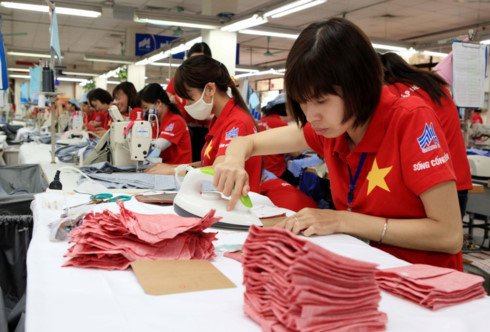
Vietnam’s exports to the Republic of Korea have enjoyed a remarkable upward trend in recent years despite suffering a slight dip last year. Both countries remain committed to future co-operation to enjoying the huge opportunities by taking full advantage of the available Free Trade Agreement networks.
At a recent seminar held to discuss ways to boost economic co-operation through the Vietnam-Korea Free Trade Agreement (VKFTA), Vu Ba Phu, director of the Trade Promotion Department under the Ministry of Industry and Trade, noted the surges in trade in recent years.
The director said after seeing one-digit economic growth rate for a long period, the country recorded import-export turnover of more than US$65 billion last year, an increase of 22.9 per cent.
The Republic of Korea (RoK) has been the nation’s second largest trading partner since three years ago when the VKFTA was first implemented. Vietnam’s key export staples to the RoK such as wood products, footwear, and garments and textiles, have witnessed significant growth since the two countries signed the VKFTA.
Specifically, taxes levied on garments and textiles have been substantially slashed with domestic firms who sell garments and textiles benefiting from a wealth of opportunities in the Korean market.
Fashion is a flourishing sector within the RoK with many Korean firms injecting capital into the fashion market and importing products to take full advantage of the preferential tariffs on offer.
Many Korean investors have rented land in Vietnam in order to build farms and co-operate with local businesses to export products such as fruit and vegetables.
Last year, Vietnam’s import surplus with the RoK increased remarkably whilst the trade deficit reached over US$30 billion. These figures show that the RoK is making full use of the advantages of the VKFTA.
Kee Hoo Kim, Advisory Specialist of the Vietnam Investment Promotion Center, said last year, Vietnam has surpassed Hong Kong (China) to become the RoK’s third largest export market after China and the US.
Vietnam has therefore risen three places since 2014, to become the RoK’s fourth largest export market.
The VKFTA has made a significant impact on the exchange of goods between the two countries, contributing to increasing the total import-export turnover and the changing bilateral trade structure.
In addition, under the tariff reduction roadmap set out by the commitments of the VKFTA, capital and investment attraction from the RoK could see a remarkable upturn as Vietnam begins to apply preferential policies.
Mr Phu noted that apart from the fresh impetus created from the VKFTA, the RoK’s New Southern Policy has targeted South and Southeast Asian nations. including Vietnam, which have played a key role in the region.
In recent times, almost all the RoK’s representative offices in Southeast Asia such as in Singapore, Malaysia, and the Philippines have relocated to Vietnam. Along with more pro-activity businesses, both nations have seen impressive growth in economic ties.
To fulfill a two-way turnover of US$100 billion worth of trade by 2020, experts believe the governments of both nations need to focus on reforming administrative procedures, attaining transparency in customs activities, and providing optimal conditions for businesses to seek investment opportunities.
Regarding trade and investment ties between the two countries, Choi Seok Yung, former RoK ambassador to the United Nations, said although the RoK is Vietnam’s second largest trade partner, the Southeast Asian nation’s exports are based around raw products to the RoK whilst lacking processed products.
Mr Choi Seok Yung called on the Vietnamese government to devise policies in a consistent and transparent manner which underscore the importance of implementing the VKFTA.
Mr Choi also underlined the need to overcome the trade deficit between the two nations and businesses with the RoK currently exporting significantly more to Vietnam.
Regarding the two nation’s future trade ties, Mr Choi emphasized the necessity of creating equality in terms of economic relations.
He advised both sides to invest in research and development activities that could potentially launch hi-tech products, establish strategic co-operation relations, and pay attention to each nation’s advantages to fully tap into the international market.
These factors could help expand market shares as well as capitalizing on FTA networks of both countries.
The RoK has so far conducted 15 FTAs while partners within the RoK's FTA network has contributed up to 73.2 per cent to the world’s GDP.
Both countries need to formulate joint projects that develop in the fields of future technologies and ho-tech, said Mr Choi, noting that the ROK has not yet joined the Comprehensive and Progressive Agreement for Trans-Pacific Partnership (CPTPP), although it has made thorough preparations for negotiations along with other nations such as Mexico and Japan.
Therefore, the possibility of using the FTA networks of both nations is expected to open up investment and trade opportunities in the future.
Fiscal revenue growth to remain under SOE divestment pressure
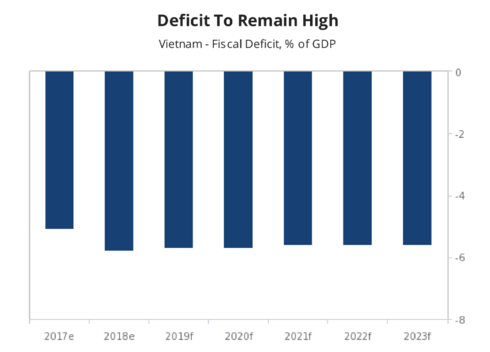
Fiscal revenue growth is forecast to remain under pressure due to a persistent delay in the divestment of state-owned enterprises and lower import tax revenues, said an overseas research unit.
Fitch Solutions, a macro research entity of Fitch Group, said in a recent report that Vietnam's fiscal deficit would stand at 5.7 per cent (including interest repayments) in 2019, relatively similar to the government’s 5.8 per cent estimate for 2018.
It stressed that the headwinds to revenue growth will constrain the government's capital spending.
Of note, the slow pace of state-owned enterprises (SOE) divestment will continue to weigh on fiscal revenue growth. In August 2017, the government set a target to divest 406 SOEs by 2020, with 135 SOEs set for divestment in 2017, and 181 in 2018. However, only 13 were divested in 2017 and 52 in 2018.
According to the Corporate Finance Department (CFD) under the Ministry of Finance, the government has identified a further 18 SOEs to be divested in 2019 and will continue the divestment at an additional 41 SOEs from the 2018 list.
Fitch Solutions quoted comments by Dang Quyet Tien, head of the CFD, as saying that some of the key challenges facing the SOE divestment include poor interest from investors, the SOE's scale of business and assets which ‘require careful valuation to avoid losses for the state budget’.
Land - related issues remain another hindrance to the SOE divestment as some SOEs had not completed their land use plans before submitting them to government agencies.
Meanwhile, though the Ho Chi Minh (HCM) benchmark equity index is trading at a premium of 17x earnings relative to its Asian peers at 13x earnings, Fitch Solutions still noted that the premium has fallen in recent months. This suggests dropping interest in the Vietnamese stock market in relation to the region.
Should the stock market see downward volatility over 2019 as a result of risk-off sentiment on fears of slowing global growth, this could hamper investor appetite for Vietnamese SOEs looking to divest by means of an initial public offering, said the research entity.
Investor interest in local SOEs has so far been weak. Last September, the state-owned Vietnam National Shipping Lines managed to raise only US$2.3 million for its 35 per cent stake sale, far underperforming the firm’s target of US$200 million. Similarly, the state-owned Viglacera Corporation reportedly failed to lure a wave of investment after it announced a plan to sell a 19.97 per cent stake last July.
Vietnam’s drive to foster greater bilateral and multilateral trading relations will also weigh on import tax revenues. In recent years, the country has been aggressively pursuing trade pacts with different countries.
Adding to the country’s current 10 free trade agreements (FTA) are six more in the pipeline, including the Regional Comprehensive Economic Partnership, the Comprehensive and Progressive Agreement for Trans-Pacific Partnership (CPTPP), and the EU-Vietnam FTA.
Most notably, it is believed that the gradual removal of import tariff lines under the CPTPP will act on import tax revenues over the coming quarters.
Moreover, the nation’s high debt burden will likely constrain capital spending. Fitch Solutions cited media reports from September 2018 as showing that the Ministry of Planning and Investment estimated the country’s public debt-to-GDP ratio to be at 61.4 per cent at the end of 2018.
The government has set a public debt ceiling at 65 per cent of GDP for the 2018-20 period. Although the estimated ratio in 2018 fell from 63.7 per cent in 2017, it nonetheless remains close to the 65 per cent limit.
Earlier this year, a high-speed rail project was restarted. The project, aimed to improve links between the north and south, is expected to be opened in stages from 2030 onward. Fitch Solutions believes that funding this project would weigh heavily on the government’s finances, particularly given that the government has to bear 80 per cent of the total bill.
As the public debt-to-GDP ration is close to the government’s 65 per cent threshold, the research firm noted the risk of a cutback in capital spending in other areas to fund the rail project, or even delays to the scheme.
The initiative was first proposed in the early 2000s, with its original completion slated for 2035. However, at an estimated cost of US$56 billion at the time, the project was deemed too expensive by the government, which eventually shelved the project in 2010.
However, Fitch Solutions declared that risks to its forecast are for a larger fiscal deficit as the government could decide to prioritize growth over fiscal prudence amidst slowing economic growth.
This could make the government borrow more to fund its expenditures, with the increase in interest repayments putting further downside pressure on the fiscal deficit over the long term.
In Saigon’s hot weather, cool things sell like hot cakes
As the sun shines scorching bright, Saigon businesses are making hay, posting record sales and profits.
Ho Chi Minh City is experiencing a heat wave, like other places in the country, with temperatures soaring to 34-37 degrees Celsius. RealFeel temperature, which indicates how hot it feels outdoors, was around 40 degrees Celsius, or 104 degrees Fahrenheit. The dry season is expected to last at least until mid-May.
The baking weather has spurred many families to buy air-conditioning devices, although an air-conditioner is not cheap at VND8 million ($344) to VND15 million ($646). The base average salary of Vietnamese workers is just VND4.6 million ($200) a month.
Dien May Xanh, an electronics retail arm of HCMC-based Mobile World Investment Corporation (MWG), one of the country’s major sellers of mobile phones, reported a record-breaking surge in the sales of air-conditioners this month.
During the three-day April 13-15 holiday break to commemorate the Hung Kings, the electronics retail chain sold more than 23,000 air conditioners and around 17,000 air-conditioning fans, 10 times higher than normal sales.
Vietnamese electronics chain Nguyen Kim has also gained handsomely from the sweltering heat wave, reporting a 70 percent surge in air-conditioner sales this month compared to the monthly average so far this year, Tuoi Tre newspaper reported.
Air-conditioned coffee shops and bubble tea stores have become even more popular in the sweltering heat.
Truc Loan, manager of a milk tea shop on Ngo Duc Ke Street next to the popular pedestrian street, Nguyen Hue, in downtown HCMC, told VnExpress International that the number of customers visiting her store, especially during the peak hours from 11 a.m. to 3 p.m., was twice as many as a normal day.
"Iced milk tea and chilled beverage are now the popular choices for many guests to cool down as outdoor temperatures reach nearly 40 degree Celsius. Some staff have had to skip their lunch to work non-stop during the peak hours."
The heat and warnings that the ultraviolet index in HCMC has risen to extremely dangerous levels have prompted people to limit going out for lunch and use delivery services instead.
Many more peole are using delivery services via online apps like GrabFood or GoViet to book their lunch, which has seen booming growth in Vietnam’s food delivery market and helped increase incomes for shippers.
Ho Hoang Viet, a 54-year-old GrabBike driver, said that he and his fellow colleagues have been receiving more orders from office staff these days, boosting their incomes to VND300,000 ($12.9)-VND500,000 ($21.6) a day from delivering lunch to offices in the downtown area.
"It was 37-38 degree Celsius at noon and I had to be as fast as I can to finish all orders before lunchtime. On several says, I have skipped lunch and only eaten bread and drank a little iced tea as there were so many orders at the same time," Viet said.
Some street vendors are also seeing their incomes increase by selling thirst-quenchers lile coconut water with kumquat, iced sugarcane juice with kumquat, tea with kumquat and honey, and Chinese herbal tea on sidewalks.
These refreshing drinks, costing VND8,000 to VND20,000 (34 - 86 cents) to each, have become the bestsellers these days.
The heat wave is likely to persist until this Saturday, weather experts have said.
Kien Giang’s district expands two-stage industrial shrimp farming
An Minh district in the Mekong Delta province of Kien Giang is expanding a two-stage industrial farming model to breed white-legged shrimp which offers high incomes to farmers and protects the environment.
It involves breeding the shrimp are in round-shaped ponds covered with anti-sunshine nets and plastic sheets on their beds in a two - stage model.
In the first, shrimp fry are bred in a nursery for a period of 25-30 days, and in the second, they are transferred to the main pond at a density of up to 450 creatures per square metre. They are raised based on Vietnamese good agricultural practice (VietGAP) standards.
Le Van Khanh, head of the An Minh District Division of Agriculture and Rural Development, said the model has been developed in the district for two years, and it offers a new advanced farming model to adapt to climate change.
“[It] is safer and more effective and sustainable compared to industrial farming in soil ponds.”
There are 15 households in the district farming white-legged shrimp using the model, according to the bureau.
They are instructed by agricultural officials to regularly replace the water in the ponds and check water quality and colour to ensure the sustainable growth of the animals and protect the environmental.
The households are also taught how to equip their ponds, treat water and waste and select shrimp fry and food for them. The crustaceans bred under the model have a survival rate of 90 percent and a yield of 50 tonnes per hectare per year.
Farmers can breed three to four crops a year using the model. Each crop lasts 60-70 days.
Nguyen Van Suoi, a farmer in the district’s Van Khanh Dong commune, said he breeds shrimp in five 500sq.m ponds and earns 70 million VND (3,000 USD) from each per crop. The model offers higher incomes than extensive farming or rotating between shrimp and rice in the same field, he said.
With its advantages like being on the coast, An Minh has excellent conditions for aquaculture, including shrimp farming. But most shrimp farming here is done using the shrimp–rice model, and yields are not high.
Khanh said the district plans to expand the industrial and semi-industrial shrimp farming models to more than 100ha by next year, focusing on the two-stage industrial farming model. But it requires large sums of investment while farmers lack the experience to implement the model, he said.
The cost of setting up a 500sq.m pond is 170-180 million VND (7,310-7,740 USD).
To develop the model, the bureau would offer training to more famers and help them get loans by petitioning the province and district, Khanh added.
Export of poultry products sees great potentials
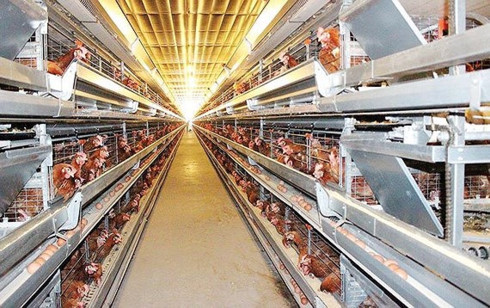
For decades, output of animal husbandry of Vietnam has mainly served domestic market. However, currently, the Ministry of Agriculture and Rural Development has opened policies to encourage firms to promote export of, first of all, poultry products to potential markets thanks to plentiful supply.
According to Mr. Nguyen Xuan Duong, head of the Department of Livestock Production, poultry farming has recently seen an improvement from small-scale farming to intensive farming.
Productivity and profits are both increasing, thus, poultry farming is no longer a secondary occupation but a main direction in agricultural production in some places.
During the past years, the number of poultry increased an average of above 6 percent annually. By 2018, production of poultry meat exceeded 1.1 million tons and production of poultry eggs topped 11 billion eggs.
Currently, farmers across the country have been raising around 409 million domestic fowls, of which chickens accounted for 77.5 percent and the rest 22.5 percent was waterfowls. Production of eggs also surged drastically with a growth of 11.4 percent. At the present, domestic fowls have been raising widely across the nation.
In the Southeast region, Binh Duong Province has the highest growth rate of 10.5 percent of poultry flock while Dong Nai has the largest poultry flock with nearly 20.5 million fowls. In the Red River Delta, Ninh Binh and Quang Ninh provinces have the highest growth and production. Ha Noi has the largest poultry flock with more than 25.6 million fowls.
Currently, there are two main models of farming, consisting of intensive farming and household-farming. Of which, intensive farming tends to develop rapidly with 10,000-12,000 farms, mainly in the Red River Delta, the Southeast region and the Mekong Delta.
As for market, Mr. Nguyen Xuan Duong said that animal husbandry in general and poultry farming in particular has served domestic consumption fairly well, contributing to price stabilization and bringing high income for farmers. However, amid increasing supply, the industry should consider export to increase economic value that animal husbandry is able to provide.
In the past three years, some firms have exported poultry products to other countries. Export value of poultry products has increasingly posted growth. Poultry exports exceeded US$3.05 million in 2016, climbed to $5.58 million in 2017 and reached more than $18 million in 2018.
Currently, poultry products of Vietnam include fresh duck eggs, boiled salted duck eggs, salted duck yolks, processed chicken meat, canned quail eggs, egg powder and braised black-bone silky chickens.
Every year, the country exports from 1.25 million to 1.5 million fowl breeders and around 10-15 million salted duck eggs. Export of chicken meat started from September 2017 and nearly touched 8,000 tons of processed chicken meat in 2018.
According to Mr. Nguyen Thanh Son, chairman of the Vietnam Poultry Association, the local poultry farming industry has a big opportunity when Vietnam has joined several free trade agreements which are expected to help firms to approach more new markets with great potential.
Amid concern that Vietnamese poultry products will not be able to compete in export markets, Mr. Nguyen Quoc Toan, acting director of the Agro Processing and Market Development Agency under the Ministry of Agriculture and Rural Development, said that firms should identify each target market and consumer taste of import country so as to divide market segment for export poultry products suitably.
For instance, firms should boost export of chicken breast because this product is in high demand and favored by import markets while chicken thighs and wings are for domestic market.
According to Mr. Toan, target markets of Vietnamese firms in exporting chicken meat include Japan, China and the Philippines and potential markets are Arab Saudi and South Africa. As for poultry eggs, firms should concentrate export to traditional markets in Northeast and Southeast Asia.
Despite plentiful supply and high import demand, Mr. Pham Van Dong, head of the Department of Animal Health, said that exporting poultry meat products is not easy because of technical barriers and strict control on food safety and hygiene from import countries.
He cited that it took the Ministry two years to negotiate with Japanese authority in order for Vietnamese chicken meat to be exported into Japan. At the present, although having received approval from Japanese authority, each batch of poultry products imported from Vietnam has to be kept for Japanese veterinary agency to check for pathogen and antibiotic residues.
Therefore, if firms want to promote export, they will have to invest in closed-loop farming system or apply modern processing technology.
In addition, they should strictly control diseases and should not use antibiotics and banned substances in farming. If there is an outbreak of diseases, export of poultry products might be possibly halted and firms will lose market.
Businesses urged to follow consumer trends for RoK market penetration
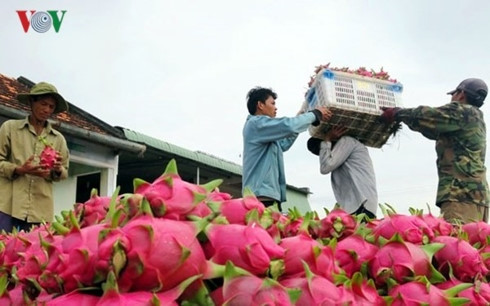
Aside from improving product quality, local businesses and producers have been urged to take on board information relating to consumers’ tastes and trends, standards and technical barriers set by the Republic of Korea in order to make inroads into the market.
The information was released by Byungsuk Chun, an advisory expert of World Friends NIPA, at a recent workshop that sought ways to boost exports to the Republic of Korea (RoK).
Currently, several Vietnamese aquatic products such as shrimp and pangasius (tra and basa fish) are being exported to the RoK market. In addition, five Vietnamese fruits have created a presence in the market, including local coconuts, pineapples, dragon fruit, mangoes, and bananas.
Despite some presence, the market share of domestic farm produce in the RoK market remains low. With the RoK spending roughly US$33 billion on importing farm produce from other countries, there are plenty of opportunities for Vietnamese farm produce to penetrate the market.
Hoang Quang Phong, Vice President of the Vietnam Chamber of Industry and Commerce, said Vietnam still records the largest trade deficit with the RoK while domestic firms have encountered a number of technical barriers in terms of food safety and hygiene.
For example, all fresh imported fruit and vegetables must have quarantine certificates issued by relevant agencies in the RoK.
For processed vegetables and fruit, local factories must meet stringent criteria such as export certificates granted by the RoK side following an extensive examination of production lines at all phases from garden to harvesting, processing, and preservation of products.
A representative from the Vietnam-RoK design centre emphasised that several of the nation’s agricultural products and handcrafts comply with the RoK consumers’ requirements relating to quality, packaging, and design.
Mr Byungsuk Chun advised local businesses to gain a better understanding of information on the market and tastes of Korean consumer to dictate more the export of Vietnamese products to the market.
RoK consumers now strongly favour products that have a natural origin and tend to seek delicious, clean, and healthy products. The demand for dietary supplements and cosmetics to enhance the immune system are particular favourites among consumers who are willing to purchase these products at high prices.
The Korean advisory expert also noted the average age of consumers. With the number of consumers above the age of 50 increasing rapidly, the target demographic for each type of product must also change accordingly.
Therefore, domestic businesses need to keep up to date with trends to successfully launch products that suit the tastes of Korean consumers in terms of design and types.
Moreover, the trend of online shopping has become a typical characteristic of the RoK market. Online trade activities based on discussions among groups on the internet have become a popular method by which consumers in the RoK order low-cost products.
Consumers often compare prices from online trading floors and websites before making decisions on their shopping activities. In addition, local businesses should pay attention to the trend of single-family homes, which has seen a remarkably rise in the RoK in recent years.
Vietnamese businesses must also study information relating to the market such as product standards and quality, whilst seeking and setting up partnerships within the RoK market. Additional opportunities can also be found at trade fairs whilst exhibitions are a useful method by which to meet partners and seek useful information.
Along with this farm produce export firms have been urged to better understand import criteria for each type of product, invest in stages such as packaging and design, and focus on a fast delivery time to ensure long-term co-operation.
Although Vietnamese exports to the RoK remain limited, the nation’s exports to the RoK will be promoted with the support from both country’s governments, Mr Byungsuk Chun noted.
The Korean expert also underlined the three basic factors in the packaging design including product, consumers, and distribution. Businesses should pay attention to materials, origin, and features before designing products as well as the competitiveness of products in comparison to similar products in the market.
He also emphasized the importance of reasonable prices in order to attract customers, noting that Vietnamese businesses should realise the benefits of an innovative design for their products and services to increase the value of export items.
Coffee festival takes place in Nha Trang
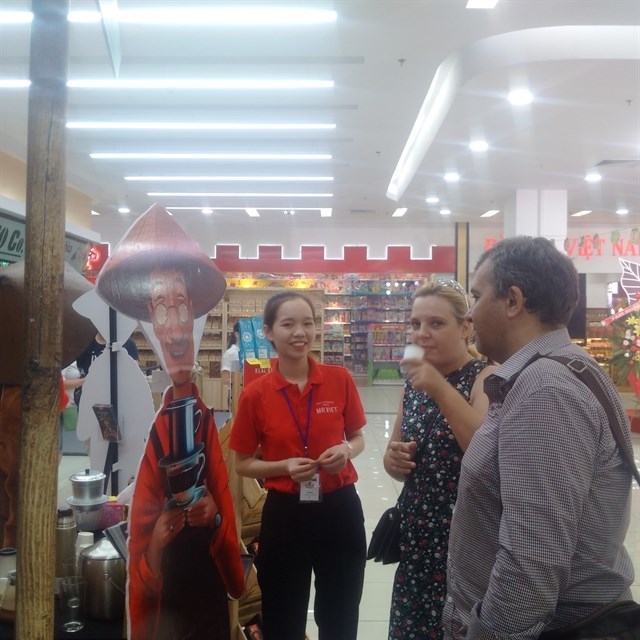
Foreign visitors taste Vietnamese coffee products at the festival.
More than 20 famous coffee brands in Vietnam are being showcased at a coffee festival in the central city of Nha Trang, south central Khanh Hoa province.
The festival, part of the Ministry of Industry and Trade (MoIT)’s programme to promote Vietnamese enterprises' direct participation in foreign distribution chains, is an opportunity for coffee producers to promote their products to coffee lovers, gradually bringing Vietnamese coffee products to the world, its organiser – the Central Group Vietnam – says in a statement.
It will also help to select quality coffee products to put into Central Group's distribution system in foreign markets, the company says, adding that up to 50,000 visitors are expected to come to this event.
During the festival, which runs until May 1, coffee products are not only displayed at Big C Nha Trang, but also at other stores and malls of Central Group Vietnam.
In his speech at the event’s opening ceremony, Ta Hoang Linh, Director of the MoIT’s European-American Market Department, stressed the importance of building the Vietnamese coffee brand and promoting its coffee products to the world.
Though Vietnam is the world’s second largest coffee exporter and is a global leading provider of Robusta coffee, the country’s export value is still modest.
The MoIT had always supported domestic coffee exporters in expanding their consumption market for not only raw products but also processed ones, Linh said.
The director said he hoped that the Central Group Vietnam would have more activities to help local producers connect with stores abroad to introduce their coffee products to the world.
Le Binh Hoa, Director of Export-Import of Central Group Vietnam, said Vietnamese Goods Week in Thailand held annually by the group is also one of the main activities that his company is organising in collaboration with the MoIT to promote and seek exporting opportunities for Vietnamese exporters, including coffee enterprises.
Farming industry group to commission cooking oil plant
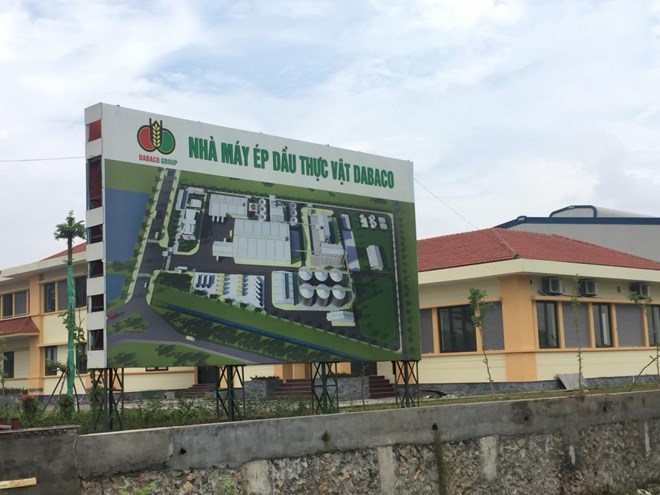
Dabaco Group's cooking oil plant in Tien Du district (Source: tuoitrethudo.com.vn)
Dabaco Group has announced that it is commissioning soon a plant to produce cooking oil in Tien Du district, the northern province of Bac Ninh, with a designed capacity of 1,000 tonnes of soya bean per day.
The farming industry group the plant will produce and refine over 80 million litres of cooking oil each year with technology and machinery originated from Europe. Besides, it is investing in a silo system with six units, each with a capacity of 5,000 tonnes, to store material. The silos are located near a port, which helps facilitates the supply of the fresh materials to the plant.
The production line is a closed and automatic one from pressing to refining and bottling using the nano technology, helping optimising the value of the product and reducing the production costs.
Dabaco Group is a Vietnam-based company is involved in the manufacturing and wholesale trade of farm supplies, such as animal feed and raw materials for animal feed manufacturing, as well as studs for livestock breeding.
Ho Chi Minh City’s CPI goes up 0.36 percent in April

Consumer price index of Ho Chi Minh City increased by 0.36 percent in April compared with that of March and 4.25 percent year-on-year, the municipal Statistical Office revealed on April 30.
Among 11 commodity groups, eight recorded monthly price increases, led by transportation (4.8 percent), apparel, headgear and footwear (0.21 percent), housing, electricity and water supply, fuel and construction materials (0.21 percent), goods and other services (0.16 percent), household equipment and appliances (0.08 percent), education (0,07 percent), beverages and tobacco (0.06 percent), and culture, entertainment and tourism (0.01 percent).
Meanwhile, decreases were seen in post and telecommunication (0.12 percent) and food and catering services (0.6 percent). Prices of medicine and medical services remained stable during the month.
Gold prices fell by 0.68 percent, while USD prices stayed stable the same in April.
HCM City focuses on State-owned firm restructuring

Ho Chi Minh City is exerting every effort to fulfil State-owned enterprise (SOE) equitisation goals during 2019-2020 as regulated in a plan to rearrange and reform SOEs approved by the Prime Minister.
According to the municipal People’s Committee, the city has 39 SOEs set to be equitised in the 2016-2020 period.
Vice Chairman of the committee Le Thanh Liem said that right in 2016, the committee made a plan on the issue to submit to the municipal Party Committee for approval.
Under the plan, the city expects to equitise 32 out of 39 SOEs in 2019, while the equitisation of the remaining will be conducted next year.
Liem stated that the People’s Committee will focus on increasing the efficiency of State management over local SOEs, and reviewing policies related to SOEs, and state capital and asset management.
To effectively use revenue from equitisation and State divestment for development, the city will implement measures related to SOE rearrangement and equitisation drastically and synchronously, he added.
HoREA offers proposals to help real estate firms access long-term bank loans

An apartment building in the Nam Trung Yen Urban Area in Cau Giay district
The Ho Chi Minh Real Estate Association (HoREA) has suggested the State Bank of Vietnam (SBV) extend the application of regulations on banks’ maximum ratio of short-term funds used for medium- and long-term loans until the end of 2020.
The HoREA also proposed the rate should be reduced to 37 percent starting from January 1, 2021; 34 percent from July 1, 2021; and 30 percent from July 1, 2022.
The moves were announced after the SBV released a draft circular stipulating that the maximum ratio of short-term funds used for medium- and long-term loans at banks would be reduced from the current 45 percent to 40 percent from 2019 to June 30, 2020.
Under the SBV’s draft circular, the rates of 37 percent and 30 percent will be applied from July 1, 2020 and July 1, 2021, respectively.
According to the HoREA, the amendments will damage the real estate market as property enterprises are in dire need of medium- and long-term loans. It explained that due to the large proportion of short-term capital in banks’ total mobilised capital, banks will find it difficult to meet the demands of the real estate market.
The HoREA said real estate firms in developed countries have raised capital from investment funds and stock markets. Bank loans are mainly provided to homebuyers. However, in Vietnam, property companies are dependent on bank loans and capital mobilised in advance from homebuyers, while most homebuyers also take loans from banks.
The local stock market has yet to become a major channel of capital access for real estate enterprises as the number of listed property firms is small. Only some 65 out of more than 1,000 real estate firms are listed on the stock market, the HoREA said.
Real estate investment funds and the stock market are unable to meet the high demand for capital in the property sector. Vietnam currently has only one investment fund for the sector, Techcom Vietnam Real Estate Investment Trust, an arm of Vietnam Technological and Commercial Joint Stock Bank, with charter capital of only 50 billion VND (2.14 million USD).
The foreign direct investment (FDI) inflow to the local real estate market is also limited and does not meet capital demands, though it accounts for some 21 percent of the country’s total FDI value, the HoREA said.
It expects the application of the amended Law on Securities this year to create favourable conditions for the establishment of real estate investment funds and trusts to provide capital for the local market.
According to the Law on Real Estate Business, investors in property projects must provide at least 15 percent of the equity or 20 percent of the investment capital. The remaining 80-85 percent of capital can be mobilised from banks or customers.
Solutions employed to fulfil fishing targets

The Ministry of Agriculture and Rural Development (MARD) has asked relevant agencies and coastal localities to employ solutions to fulfill targets set for the fishing season from April through September.
The Directorate of Fisheries was requested to coordinate with other concerned agencies to keep a close watch on weather developments as well as security and order at sea in order to take suitable solutions in support of fishermen.
Apart from implementing the Law on Fisheries and relevant legal documents, greater efforts should be made to remove the European Commission (EC)’s “yellow card” warnings on Vietnamese seafood, the ministry said.
The MARD’s Agro Processing and Market Development Authority (AgroTrade) needs to intensify trade promotion, support and protect copyright and brand names, assess processing capacity of factories nationwide and develop consumer markets at home and abroad.
The National Agro-Forestry-Fisheries Quality Assurance was urged to synchronously implement solutions to deal with export items under food safety warnings in markets.
Meanwhile, coastal localities were asked to set forth programmes and plans to realise the Law on Fisheries and popularise new legal documents among organisations, fishermen and local people.
The ministry urged the localities to step up the management of fishing boats and grounds, while upgrading fishing ports and ship shelters.
Localities should encourage businesses to join hands with fishermen to participate in production chains to ensure post-harvest quality and improve seafood values, increase technological application and ensure hygiene at processing facilities, it said.
During the fishing season, aquatic catch is expected to hit 2.1 million tonnes and turnover from seafood exports is set at 3.38 billion USD, up 13.2 percent year-on-year.